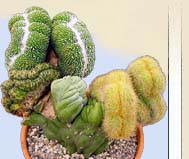Indoor
Floriculture

Leafy succulents
by Peter Lapshin

Cacti Library
'Cultivar' (V.Kalishev)

Moscow
Succulent Society

Moscow Indoor
Plant Club

Travels, nature,
botanical gardens

About Episcia
(Gesneriaceae)
 |
 |
CULTIVAR / КУЛЬТИВАР e-Magazine about exotic forms of Cactaceae ENGLISH / RUS-(Win1251) | |||
|
|
|

|
Mojave Desert Cacti by Vladimir Malov, California USA
Kolob platoe Cylindropuntia whipplei, Opuntia macrorhisa, Opuntia sp 'basilaris', Echinocereus coccineus I head back to my car. It's almost noon and the weather with light breeze is beautiful –and soft overcast sky is perfect for my photos. It's time to go to Kolob, which is located at the north end of the Zion park, and isn't a place I've visited before. I stop by a farmer's market selling local apples, peaches, squeezed juice and homemade oatmeal pastry. Surrounded by the rocky desert, the land along the streams is cultivated, with orchards, small fields and pastures. Mormons had settled on this land over a hundred years ago, and their houses are easy to spot by the distinct small "towers" built on the roofs. Highway 9 takes me to the Kolob road that runs along another valley and stream. I pass other several houses and small pastures, stopping occasionally to check for plants. On a north-facing slope I found plenty of Opuntias among the oak tress, while bare south-facing slope has some large mounds of Echinocereus coccineus and also more Opuntias. The road starts to rise and finally climbs up to the narrow basalt plateau. Road here is surrounded by junipers and dense Opuntias growing in the low yellow grass. I stop again to examine the area. The basalt plateau that's only a hundred yards wide, appears to be a flow of lava that filled the valley a long time ago. The soft sandstone of the old valley slopes has been washed away, leaving the lava on some kind of pedestal. The Opuntias are plentiful here, along with smaller Echinocereus coccinneus plants. The Opuntias are the ubiquitous macrorhisa and the same "basilaris-variation." There is also a plant I have't seen before – Cyllindropuntia whippley, which is easy to recognize by its round yellow, tuberculate and spineless fruit. The Opuntia macrorhisa and Cylindropuntia tend to grow in the open, the "basilaris" hides under the bushes and the juniper trees, and Eshinocerei are restricted to the sunny edge of the basalt cliff and the slope below. Half a mile down the road I make another stop. Opuntia macrorhisa are decorated with bright cherry-red fruit that contrast nicely with the washed-out yellow of the dry grass and the solid green of the Opuntia pads. I spend some time just walking around and photographing this beauty.
Further down the road I see no more fruit-bearing Opuntias, actually I see no more Opuntias at all. Low oak bushes covered with dry brown leaves grow densely along the way. I stop and find no cacti. I continue on and suddenly find myself in a great wide-open space. The scenery is astonishing – yellow meadows with patches of sand and desert bushes, groves of brown oak bushes and colorful, wild-looking rocks. This is the Kolob plateau.
|
| Cultivar e-magazin: Copyright (c) by Valery Kalishev, Chelyabinsk, Russia, since 2000. Design and hosting by Peter Lapshin, since 2002. Contacts: Peter Lapshin |
|
|